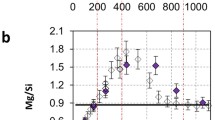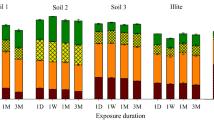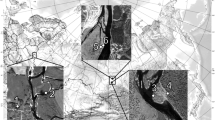Abstract—
The natural soil-forming process is currently significantly impacted by human activities. Intense agricultural production intensifies the weathering and transformation processes of soil clay minerals, which were inherited from rocks and contain much potassium available to plants. A positive balance of vermiculite is a reliable diagnostic criterion of soil depletion in potassium, and therefore, monitoring of the content of this mineral is necessary to regulate soil fertility. A new method is proposed for quantitative determination of vermiculite in soils. The method is based on the ability of 2 : 1 clay minerals to selectively adsorb and fix Cs+. The procedure includes the saturation of soil exchange complex with Cs+ labeled with 137Сs. To do this, the sample is washed with CsCl solution with a trace level of 137Cs. After oven-drying at 110°C, which results in partial Cs+ fixation in the crystal lattice, the exchangeable Cs+ is replaced by \({\text{N}}{{{\text{H}}}_{4}}^{ + }\). The activity concentration of the fixed 137Сs is then determined by gamma spectrometry. Given a known ratio of Cs+ content to 137Cs activity concentration, the vermiculite quantity in soils is calculated from the ratio of the fixed Cs+ amount to the vermiculite interlayer exchange capacity, which is assumed to be 154 mg-equiv/100 g. Vermiculite content was determined in samples of arable soils, which have been collected in different climate zones of the European part of Russia. Among the soils, the lowest vermiculite content was found in soddy-podzolic soil (2.3 g/kg) and the highest one was detected in chernozems (26.9–28.6 g/kg). It is shown that vermiculite is also present in coarse fractions of soils (with particle size >1 µm). Among all soil samples, the highest content of vermiculite in coarse fractions was found in sandy soddy-podzolic soil (20.8% of the total content in soil), whereas this value in loamy and clay soils varied between 2.1 and 5.4%.

Similar content being viewed by others
REFERENCES
C. A. Alexiades and M. L. Jackson, “Quantitative determination of vermiculite in soils, Soil Sci. Soc. Am. Proc. 29, 522–527 (1965).
E. V. Arinushkina, Manual on the Chemical Analysis of Soils (Mosk. Gos. Univ., Moscow, 1970) [in Russian]
M. Badraouri and P. R. Bloom, “The effects of wetting and drying cycles, temperature and extracting solutions on measured potassium fixation in soils of two regions of Morocco,” Comm. Soil Sci. Plant Anal. 20 (13–14), 1353–1375 (1989).
R. Bouabid, M. Badraoui, and P. R. Bloom, “Potassium fixation and charge characteristics of soil clays,” Soil. Sci. Soc. Am. J. 55, 1493–1498 (1991).
E. Brouwer, B. Baeyens, A. Maes, and A. Cremers, “Cesium and rubidium ion equilibria in illite clay,” J. Phys. Chem. 87, 1213–1219 (1983).
C. B. Coffman and D. S. Fanning, “‘Vermiculite’ determination on whole soils by cation exchange capacity methods,” Clays Clay Miner. 22, 271–283 (1974).
A. De Koning, A. V. Konoplev, and R. N. J. Comans, “Measuring the specific caesium sorption capacity of soils, sediments and clay minerals,” Appl. Geochem. 22 (1), 219–229 (2007).
Q. Fan, N. Yamaguchi, M. Tanaka, H. Tsukada, and Y. Takahashi, “Relationship between the adsorption species of cesium and radiocesium interception potential in soil sand minerals: an EXAFS study,” J. Environ. Radioact. 138, 92–100 (2014). https://doi.org/10.1016/j.jenvrad.2014.08.009
K. Feng, X. L. Wang, X. Z. Wnag, and Y. Tang, “Relationship between 2 : 1 mineral structure and the fixation and release of cations,” Pedosphere. 13, 81–86 (2003).
A. E. Hartemink, “Soil fertility decline in some major soil groupings under permanent cropping in Tanga Region, Tanzania,” Geoderma 15, 215–229 (1997).
M. L. Jackson, “Interlayering of expansible layer silicates in soils by chemical weathering,” Clays Clay Miner. 11, 29–46 (1963).
J. P. Møberg and J. D. Nilson, “Mineralogical changes in soils used for potassium-depletion experiments for some years in pots and in field,” Acta Agric. Scand. 33, 21–27 (1983).
D. M. Moore and R. C. Reynolds, X-Ray Diffraction and Identification and Analysis of Clay Minerals (Oxford University Press, Oxford–New York, 1997).
B. V. Nekrasov, Principles of General Chemistry (Khimiya, Moscow, 1973), vol. 1 [in Russian].
T. Ohnuki and N. Kozai, “Adsorption behavior of radioactive cesium by non-mica minerals,” J. Nucl. Sci. Technol. 50, 369–375 (2013).
Y. B. Page and L.D. Baver, “Ionic size in relation to fixations by colloidal clay,” Soil Sci. Soc. Am. Proc. 4 (2), 150–160 (1940).
Practicum on Soil Science, Ed. by I. S. Kaurichev (Kolos, Moscow, 1980) [in Russian].
B. Rahmatullah, Z. Shaikh, M. A. Gill, and M. Salim, “Bioavailable potassium in riverbed sediments and release of interlayer potassium in irrigated arid soils,” Soil Use Manag. 10, 43–46 (1994).
G. J. Ross, P. A. Phillips, and J. L. R. Culley, “Transformation of vermiculite to pedogenic mica by fixation of potassium and ammonium in a six-year field manure application experiment,” Can. J. Soil Sci. 65, 599–603 (1985).
G. J. Ross, P. A. Schuppli, and C. Wang, “Quantitative determination of vermiculite by a Rubidium fixation method,” Soil Sci. Soc. Am. J. 53, 1588–1589 (1989).
B. L. Sawhney, “Selective sorption and fixation of cations by clay minerals: a review,” Clays Clay Miner. 20, 93–100 (1972).
M. Simonsson, S. Andersson, Y. Andrist-Rangel, S. Hillier, L. Mattsson, and I. Öborn, “Potassium release and fixation as a function of fertilizer application rate and soil parent material,” Geoderma. 140, 188–198 (2007).
M. Simonsson, S. Hillier, and I. Öborn, “Changes in clay minerals and potassium fixation capacity as a result of release and fixation of potassium in long-term field experiments,” Geoderma. 151, 109–120 (2009). https://doi.org/10.1016/j.geoderma.2009.03.018
T. A. Sokolova, T. Ya. Dronova, and I. I. Tolpeshta, Clay Minerals in Soils (Grif i K, Tula, 2005) [in Russian].
T. A. Sokolova, F. R. Zaidel’man, and T. M. Ginzburg, “Clay minerals in chernozem-like soils of mesodepressions in the northern forest–steppe of European Russia,” Euras. Soil Sci. 43 (1), 76–84 (2010).
V. Šucha and V. Širáńová, “Ammonium and potassium fixation in smectite by wetting and drying,” Clays Clay Miner. 39, 556–559 (1991).
H. W. Van der Marel, “Potassium fixation in Dutch soils: mineralogical analyses,” Soil Sci. 78 (3), 163–166 (1954).
ACKNOWLEDGMENTS
The authors thank Dr. N.I. Sanzharova for providing soil samples for this research and for fruitful discussions. Dr. T.A. Sokolova and the staff of the Department of Soil Chemistry at the Faculty of Soil Science of the Moscow State University are thanked for conducting mineralogical analysis of the samples.
Author information
Authors and Affiliations
Corresponding author
Additional information
Translated by E. Kurdyukov
Rights and permissions
About this article
Cite this article
Konopleva, I.V., Zabezhaylova, A.A. Using 137Cs in the Assessment of Vermiculite Content in Arable Soils in the European Part of Russia. Geochem. Int. 59, 516–521 (2021). https://doi.org/10.1134/S0016702921050037
Received:
Revised:
Accepted:
Published:
Issue Date:
DOI: https://doi.org/10.1134/S0016702921050037




